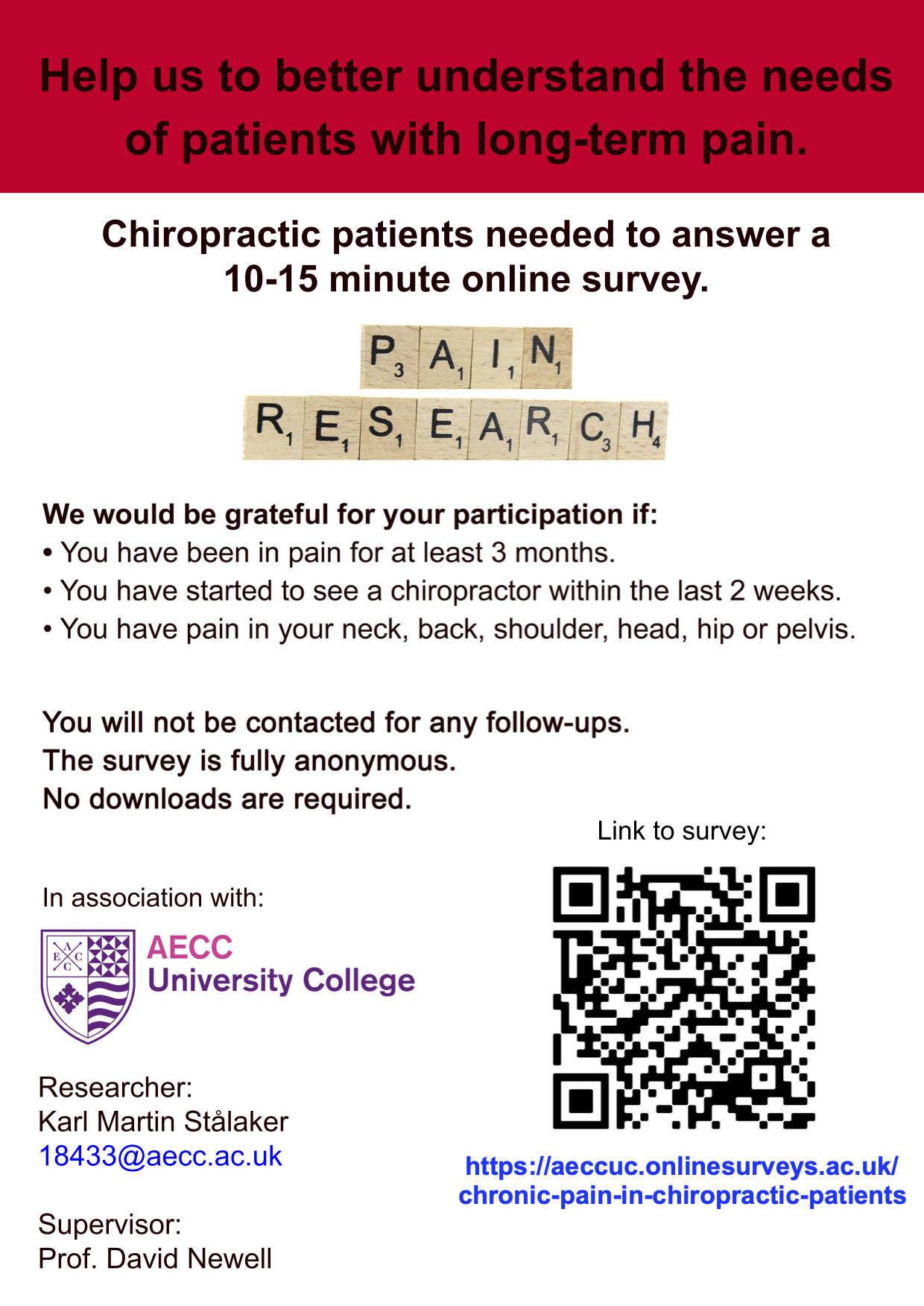Research Study:

Clickable link to start patient survey:
https://aeccuc.onlinesurveys.ac.uk/chronic-pain-in-chiropractic-patients
If you are a chiropractor working in the UK, we would be grateful if you would help us to recruit some of your patients for a research study:
Research Study Title: “The prevalence of central sensitization in chiropractic patients presenting with chronic musculoskeletal pain“
We require new patients, who:
- have started to see a chiropractor for the first time within the last two weeks.
- have pain in their back, neck, shoulder, head, hip or pelvis
- have been in pain for at least 3 months
- have never had a stroke, cancer, spinal cord injury or certain neurological diseases (e.g., dementia, Alzheimer’s, Parkinson’s)
Principal Investigator: Karl Martin Stålaker
Associated University: AECC University College, Bournemouth
Background: As part of his postgraduate Master’s degree in Musculoskeletal Neuroscience, Karl is doing research on chronic pain and central sensitisation. Chronic pain can be considered to be a disease in itself, in which physical symptoms are the cumulative manifestation of biological, psychological, and social factors. There are three categories of chronic pain: (1) nociceptive (from tissue injury), (2) neuropathic (from nerve injury), (3) nociplastic (from a sensitised nervous system).
The underlying aetiology of nociplastic pain is likely to be a neurophysiological process called central sensitisation, whereby amplification of neural signalling within the central nervous system elicits pain hypersensitivity (Woolf, 2011). Central sensitisation is frequently associated with hypersensitivity in domains other than just pain, and is often present in conditions such as post-traumatic stress disorder (PTSD), irritable bowel syndrome, over-active bladder, multiple chemical sensitivity, restless leg syndrome, chronic fatigue, sleep disturbances, depression, anxiety, and hypersensitivity to stimuli such as lights, sounds and smells.
Many chronic musculoskeletal conditions can be associated with central sensitisation; these include persistent neck pain, chronic low back pain, subacromial impingement syndrome, tennis elbow, fibromyalgia, tension-type headache and migraine. However, not all patients with these conditions are centrally sensitised. For clinicians who deal with the treatment and rehabilitation of musculoskeletal disorders, it is important to be able to distinguish between patients who are centrally sensitised and those who are not, as the presence of central sensitisation is likely to require an approach to treatment that is aimed reversing unfavourable neuroplasticity within the central nervous system (Roldán-Jiménez et al., 2020; Woolf, 2011).
Manual therapists may have a vital role to play in the treatment of patients with nociplastic pain +/- central sensitisation: It has been suggested that interventions commonly used in manual therapy disciplines, such as motor control and motor learning exercises, sensorimotor training, and potentially manual therapy itself, may induce favourable neuroplasticity in chronic pain patients (Roy et al., 2017; Snodgrass et al., 2014).
The aim of this research is to determine how many chiropractic patients with long-term pain are likely to have central sensitisation. The survey used in this study contains the Central Sensitisation Inventory (CSI), a patient self-report instrument that has been deemed to be a reliable and valid measure of the severity of central sensitisation-related symptoms (Scerbo et al., 2018). In addition, the survey collects anonymous sociodemographic data in order to assess whether there is an association between the presence of certain sociodemographic factors and the presence of central sensitisation.
How to invite your patients to take part:
- Display a poster in your waiting area. You can download it here:
https://neuroseminars.co.uk/wp-content/uploads/2021/12/Chronic_Pain_Survey.pdf
If you prefer us to send you a hard copy, then please email Karl (18433@aecc.ac.uk) and we will get one in the post to you. - Email the poster (see link above) to your new patients with chronic pain.
- Give your new patients with chronic pain the link to this webpage and they can access the link to the survey from there: https://neuroseminars.co.uk/chronic-pain-in-chiropractic-patients
- Give your new patients the direct link to the survey: https://aeccuc.onlinesurveys.ac.uk/chronic-pain-in-chiropractic-patients
Or
Or
Or